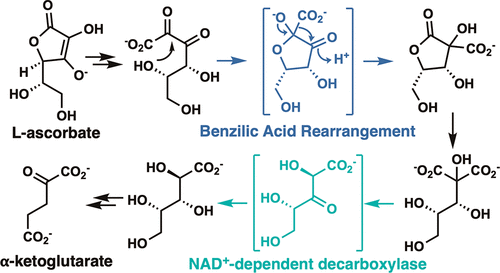当前位置:
X-MOL 学术
›
J. Am. Chem. Soc.
›
论文详情
Our official English website, www.x-mol.net, welcomes your
feedback! (Note: you will need to create a separate account there.)
Characterization of an L-Ascorbate Catabolic Pathway with Unprecedented Enzymatic Transformations
Journal of the American Chemical Society ( IF 14.4 ) Pub Date : 2020-01-09 , DOI: 10.1021/jacs.9b09863 Tyler M M Stack 1 , Katelyn N Morrison 2 , Thomas M Dettmer 2 , Brendan Wille 3 , Chan Kim 3 , Ryan Joyce 3 , Madison Jermain 3 , Yadanar Than Naing 3 , Khadija Bhatti 3 , Brian San Francisco 1 , Michael S Carter 1, 3 , John A Gerlt 1, 4
Journal of the American Chemical Society ( IF 14.4 ) Pub Date : 2020-01-09 , DOI: 10.1021/jacs.9b09863 Tyler M M Stack 1 , Katelyn N Morrison 2 , Thomas M Dettmer 2 , Brendan Wille 3 , Chan Kim 3 , Ryan Joyce 3 , Madison Jermain 3 , Yadanar Than Naing 3 , Khadija Bhatti 3 , Brian San Francisco 1 , Michael S Carter 1, 3 , John A Gerlt 1, 4
Affiliation

|
L-Ascorbate (vitamin C) is ubiquitous in both our diet and the environment. Here we report that Ralstonia eutropha H16 (Cupriavidus necator ATCC 17699) uses L-ascorbate as sole carbon source via a novel catabolic pathway. RNAseq identified eight candidate catabolic genes, sequence similarity networks and genome neighborhood networks guided predictions for function of the encoded proteins, and the predictions were confirmed by in vitro assays and in vivo growth phenotypes of gene dele-tion mutants. L-Ascorbate, a lactone, is oxidized and ring-opened by enzymes in the cytochrome b561 and gluconolactonase families, respectively, to form 2,3-diketo-L-gulonate. A protein predicted to have a WD40-like fold catalyzes an unprecedented benzilic acid rearrangement involving migration of a carboxylate group to form 2-carboxy-L-lyxonolactone; the lactone is hydrolyzed by a member of the amidohydrolase superfamily to yield 2-carboxy-L-lyxonate. A member of the PdxA family of oxidative decarboxylases catalyzes a novel decarboxylation that uses NAD+ catalytically. The product, L-lyxonate, is catabolized to α-ketoglutarate by a previously characterized pathway. The pathway is found in hundreds of bacteria, including the pathogens Pseudomonas aeruginosa and Acinetobacter baumannii.
中文翻译:

具有前所未有的酶促转化的 L-抗坏血酸分解代谢途径的表征
L-抗坏血酸(维生素 C)在我们的饮食和环境中无处不在。在这里,我们报告了 Ralstonia eutropha H16(Cupriavidus necator ATCC 17699)通过一种新的分解代谢途径使用 L-抗坏血酸作为唯一的碳源。RNAseq 确定了 8 个候选分解代谢基因,序列相似性网络和基因组邻域网络指导对编码蛋白质功能的预测,并且这些预测通过基因缺失突变体的体外测定和体内生长表型得到证实。L-抗坏血酸是一种内酯,分别被细胞色素 b561 和葡糖酸内酯酶家族中的酶氧化和开环,形成 2,3-二酮-L-古洛糖酸。一种预测具有 WD40 样折叠的蛋白质催化了前所未有的苯甲酸重排,包括羧酸盐基团迁移形成 2-羧基-L-莱克糖内酯;内酯被酰胺水解酶超家族的一个成员水解,产生 2-羧基-L-lyxonate。PdxA 氧化脱羧酶家族的一个成员催化使用 NAD+ 催化的新型脱羧。产物 L-lyxonate 通过先前表征的途径分解代谢为 α-酮戊二酸。该途径存在于数百种细菌中,包括病原体铜绿假单胞菌和鲍曼不动杆菌。
更新日期:2020-01-09
中文翻译:

具有前所未有的酶促转化的 L-抗坏血酸分解代谢途径的表征
L-抗坏血酸(维生素 C)在我们的饮食和环境中无处不在。在这里,我们报告了 Ralstonia eutropha H16(Cupriavidus necator ATCC 17699)通过一种新的分解代谢途径使用 L-抗坏血酸作为唯一的碳源。RNAseq 确定了 8 个候选分解代谢基因,序列相似性网络和基因组邻域网络指导对编码蛋白质功能的预测,并且这些预测通过基因缺失突变体的体外测定和体内生长表型得到证实。L-抗坏血酸是一种内酯,分别被细胞色素 b561 和葡糖酸内酯酶家族中的酶氧化和开环,形成 2,3-二酮-L-古洛糖酸。一种预测具有 WD40 样折叠的蛋白质催化了前所未有的苯甲酸重排,包括羧酸盐基团迁移形成 2-羧基-L-莱克糖内酯;内酯被酰胺水解酶超家族的一个成员水解,产生 2-羧基-L-lyxonate。PdxA 氧化脱羧酶家族的一个成员催化使用 NAD+ 催化的新型脱羧。产物 L-lyxonate 通过先前表征的途径分解代谢为 α-酮戊二酸。该途径存在于数百种细菌中,包括病原体铜绿假单胞菌和鲍曼不动杆菌。











































 京公网安备 11010802027423号
京公网安备 11010802027423号